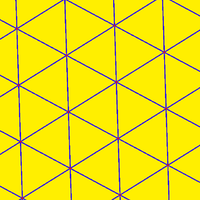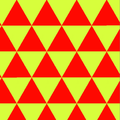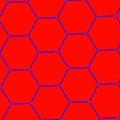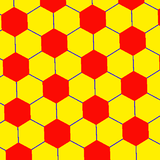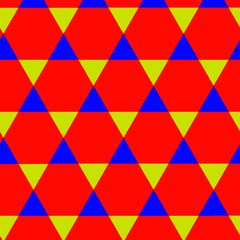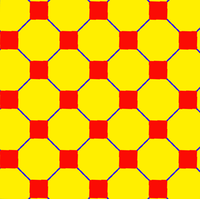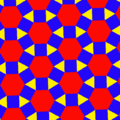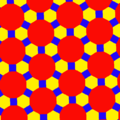List of convex uniform tilings
This table shows the 11 convex uniform tilings (regular and semiregular) of the Euclidean plane, and their dual tilings.
There are three regular, and eight semiregular, tilings in the plane. The semiregular tilings form new tilings from their duals, each made from one type of irregular face.
Uniform tilings are listed by their vertex configuration, the sequence of faces that exist on each vertex. For example 4.8.8 means one square and two octagons on a vertex.
These 11 uniform tilings have 32 different uniform colorings. A uniform coloring allows identical sided polygons at a vertex to be colored differently, while still maintaining vertex-uniformity and transformational congruence between vertices. (Note: Some of the tiling images shown below are not color-uniform)
In addition to the 11 convex uniform tilings, there are also 14 nonconvex tilings, using star polygons, and reverse orientation vertex configurations.
The dual tilings of these tilings have vertices at the centers of the regular polygons, and edges connecting centers of regular polygons that share an edge. The tiles of the dual tiling are not necessarily regular themselves, but each vertex has edges evenly spaced around it. These dual tilings are listed by their face configuration, the number of faces at each vertex of a face. For example V4.8.8 means isosceles triangle tiles with one corner with 4 triangles, and two corners containing 8 triangles.
In the 1987 book, Tilings and Patterns, Branko Grünbaum calls the vertex-uniform tilings Archimedean in parallel to the Archimedean solids, and their dual tilings Laves tilings in honor of crystallographer Fritz Laves.[1] John Conway calls the duals Catalan tilings, in parallel to the Catalan solid polyhedra.[2]
Convex uniform tilings of the Euclidean plane

 , [3[3]] family symmetry is completely contained within
, [3[3]] family symmetry is completely contained within  , [6,3] symmetry cases. A doubling of the [4,4] symmetry produces another [4,4] symmetry.
, [6,3] symmetry cases. A doubling of the [4,4] symmetry produces another [4,4] symmetry.All reflectional forms can be made by Wythoff constructions, represented by Wythoff symbols, or Coxeter-Dynkin diagrams, each operating upon one of three Schwarz triangle (4,4,2), (6,3,2), or (3,3,3), with symmetry represented by Coxeter groups: [4,4], [6,3], or [3[3]]. Alternated forms such as the snub can also be represented by special markups within each system. Only one uniform tiling can't be constructed by a Wythoff process, but can be made by an elongation of the triangular tiling. An orthogonal mirror construction [∞,2,∞] also exists, seen as 2 sets of parallel mirrors making a rectangular fundamental domain. If the domain is square, this symmetry can be doubled by a diagonal mirror into the [4,4] family.
Families:
- (4,4,2),
 , [4,4] - Symmetry of the regular square tiling
, [4,4] - Symmetry of the regular square tiling
-
 , [∞,2,∞]
, [∞,2,∞]
-
- (6,3,2),
 , [6,3] - Symmetry of the regular hexagonal tiling and triangular tiling.
, [6,3] - Symmetry of the regular hexagonal tiling and triangular tiling.
- (3,3,3),
 , [3[3]]
, [3[3]]
- (3,3,3),
The [4,4] group family
| Uniform tilings (Platonic and Archimedean) |
Vertex figure Wythoff symbol(s) Symmetry group Coxeter-Dynkin diagram(s) |
Dual-uniform tilings (called Laves or Catalan tilings) |
|---|---|---|
 Square tiling (quadrille) |
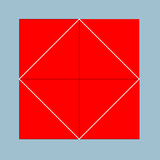 4.4.4.4 (or 44) 4 | 2 4 p4m, [4,4], (*442) |
 self-dual (quadrille) |
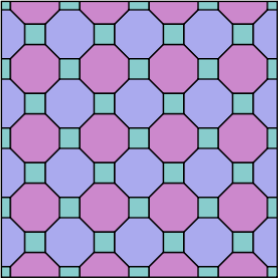 Truncated square tiling (truncated quadrille) |
 4.8.8 2 | 4 4 4 4 2 | p4m, [4,4], (*442) |
 Tetrakis square tiling (kisquadrille) |
 Snub square tiling (snub quadrille) |
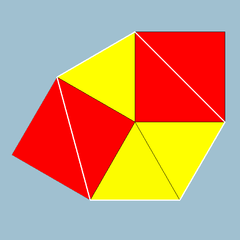 3.3.4.3.4 | 4 4 2 p4g, [4+,4], (4*2) p4, [4,4]+, (442) |
 Cairo pentagonal tiling (4-fold pentille) |
The [6,3] group family
| Platonic and Archimedean tilings | Vertex figure Wythoff symbol(s) Symmetry group Coxeter-Dynkin diagram(s) |
Dual Laves tilings |
|---|---|---|
 Hexagonal tiling (hextille) |
 6.6.6 (or 63) 3 | 6 2 2 6 | 3 3 3 3 | p6m, [6,3], (*632) |
 Triangular tiling (deltille) |
 Trihexagonal tiling (hexadeltille) |
 (3.6)2 2 | 6 3 3 3 | 3 p6m, [6,3], (*632) p3m1, [3[3]], (*333) |
 Rhombille tiling (rhombille) |
 Truncated hexagonal tiling (truncated hextille) |
 3.12.12 2 3 | 6 p6m, [6,3], (*632) |
 Triakis triangular tiling (kisdeltille) |
 Triangular tiling (deltille) |
 3.3.3.3.3.3 (or 36) 6 | 3 2 3 | 3 3 | 3 3 3 p6m, [6,3], (*632) p3m1, [3[3]], (*333) p3, [3[3]]+, (333) |
 Hexagonal tiling (hextille) |
 Rhombitrihexagonal tiling (rhombihexadeltille) |
 3.4.6.4 3 | 6 2 p6m, [6,3], (*632) |
 Deltoidal trihexagonal tiling (tetrille) |
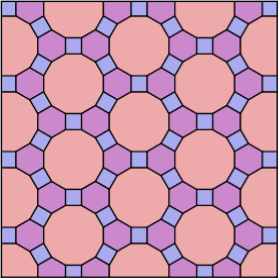 Truncated trihexagonal tiling (truncated hexadeltille) |
 4.6.12 2 6 3 | p6m, [6,3], (*632) |
 Kisrhombille tiling (kisrhombille) |
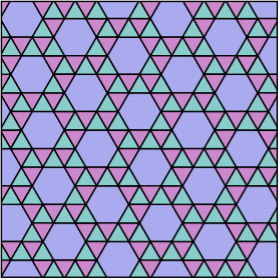 Snub trihexagonal tiling (snub hextille) |
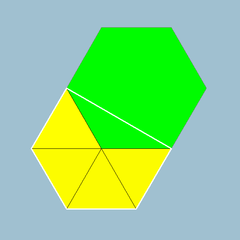 3.3.3.3.6 | 6 3 2 p6, [6,3]+, (632) |
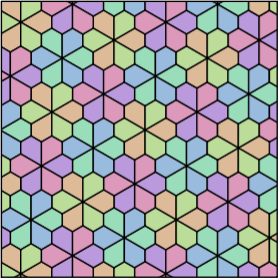 Floret pentagonal tiling (6-fold pentille) |
Non-Wythoffian uniform tiling
| Platonic and Archimedean tilings | Vertex figure Wythoff symbol(s) Symmetry group Coxeter-Dynkin diagram |
Dual Laves tilings |
|---|---|---|
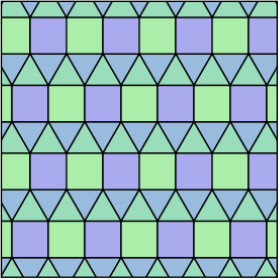 Elongated triangular tiling (isosnub quadrille) |
 3.3.3.4.4 2 | 2 (2 2) cmm, [∞,2+,∞], (2*22) pgm, [(∞,2)+,∞], (22*) pgg, [(∞,2)+,∞+], (22×) |
 Prismatic pentagonal tiling (iso(4-)pentille) |
Uniform colorings
There are a total of 32 uniform colorings of the 11 uniform tilings:
- Triangular tiling - 9 uniform colorings, 4 wythoffian, 5 nonwythoffian
-
- Square tiling - 9 colorings: 7 wythoffian, 2 nonwythoffian
-
- Hexagonal tiling - 3 colorings, all wythoffian
-
- Trihexagonal tiling - 2 colorings, both wythoffian
-
- Snub square tiling - 2 colorings, both alternated wythoffian
-
- Truncated square tiling - 2 colorings, both wythoffian
-
- Truncated hexagonal tiling - 1 coloring, wythoffian
-
- Rhombitrihexagonal tiling - 1 coloring, wythoffian
-
- Truncated trihexagonal tiling - 1 coloring, wythoffian
-
- Snub hexagonal tiling - 1 coloring, alternated wythoffian
-
- Elongated triangular tiling - 3 coloring, nonwythoffian
-
See also
- Uniform tiling
- Convex uniform honeycomb - The 28 uniform 3-dimensional tessellations, a parallel construction to the convex uniform Euclidean plane tilings.
- Uniform tilings in hyperbolic plane
- Percolation threshold
References
- ↑ Grünbaum, Branko; Shephard, G. C. (1987). Tilings and Patterns. W. H. Freeman and Company. ISBN 0-7167-1193-1.
- ↑ The Symmetries of things, Chapter 21, Naming the Archimedean and Catalan polyhedra and tilings, Euclidean Plane Tessellations, p. 288
Further reading
- John H. Conway, Heidi Burgiel, Chaim Goodman-Strass, The Symmetries of Things 2008, ISBN 978-1-56881-220-5 (Chapter 19, Archimedean tilings, table 19.1, Chapter 21, Naming Archimedean and Catalan polyhedra and tilings, p288 table).
- H.S.M. Coxeter, M.S. Longuet-Higgins, J.C.P. Miller, Uniform polyhedra, Phil. Trans. 1954, 246 A, 401–50.
- Williams, Robert (1979). The Geometrical Foundation of Natural Structure: A Source Book of Design. Dover Publications, Inc. ISBN 0-486-23729-X. (Section 2–3 Circle packings, plane tessellations, and networks, pp 34–40).
- Asaro, et. al. "Uniform edge-c-colorings of the Archimedean Tilings", .
- Grünbaum, Branko & Shepard, Geoffrey (Nov. 1977). "Tilings by Regular polygons", Vol. 50, No. 5.
External links
- Weisstein, Eric W., "Uniform tessellation", MathWorld.
- Uniform Tessellations on the Euclid plane
- Tessellations of the Plane
- David Bailey's World of Tessellations
- k-uniform tilings
- n-uniform tilings
| ||||||||||||||||||||||||||||||||||||||||||||||||||||||||||
